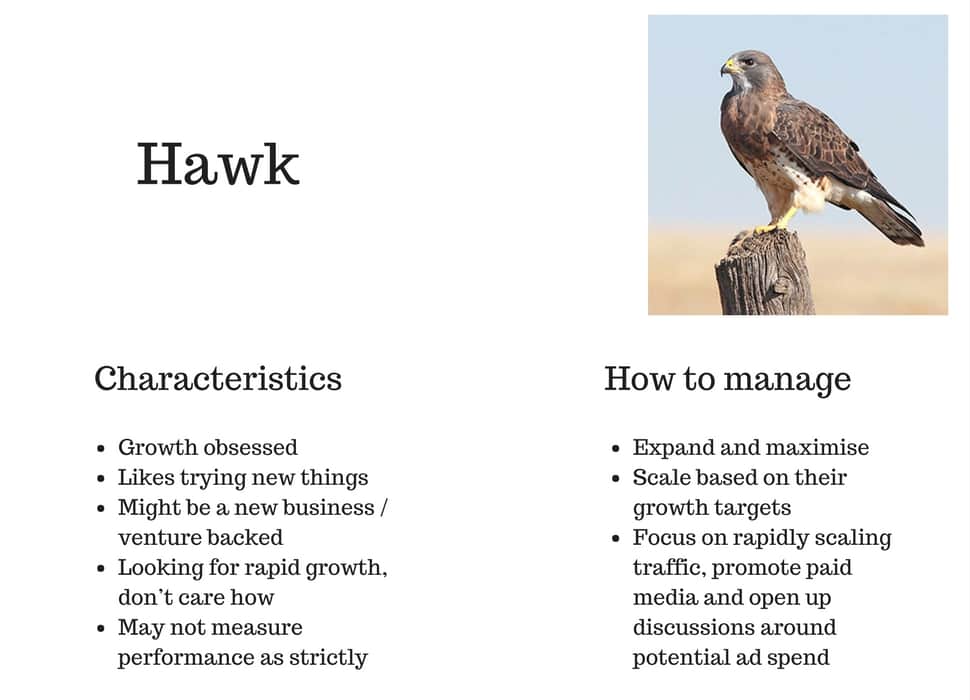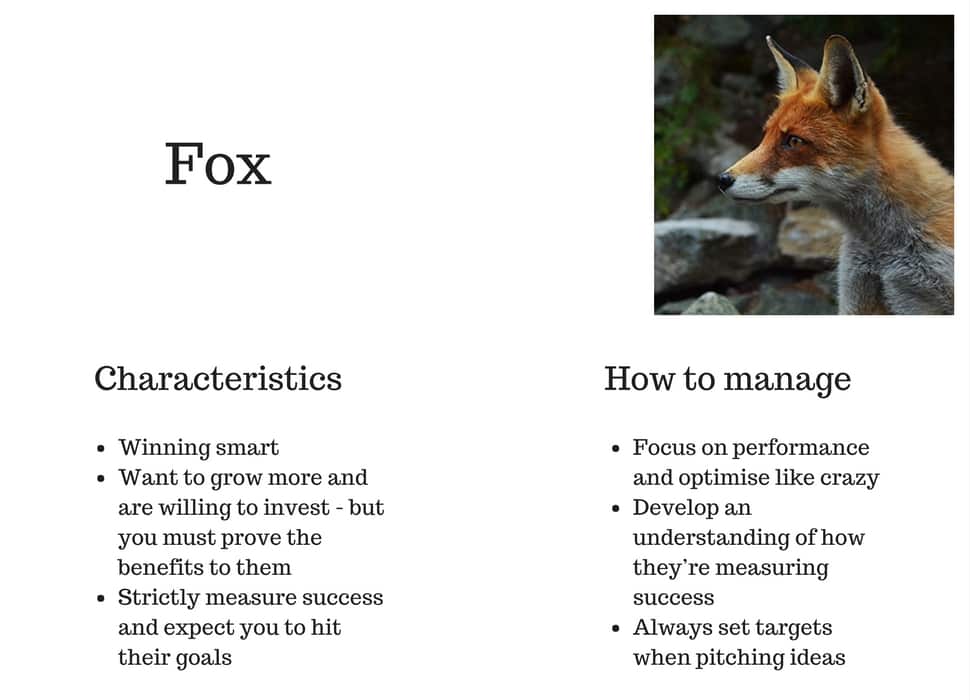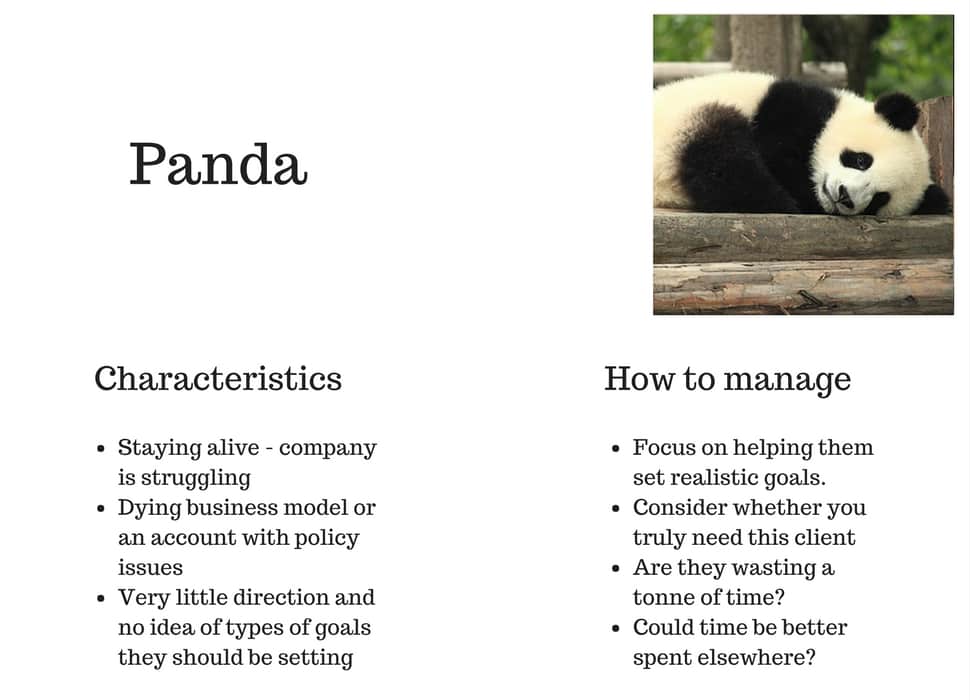If you have ever worked in a marketing agency there’s no doubt you’re familiar with buyer personas. Buyer personas can help characterise key segments of an audience with the aim of delivering the most relevant messages to each segment.
The same holds for agency account management. Building personas for your existing clients can help your account managers improve the way they communicate with their clients which in turn can boost client retention.
How to Identify Client Personas
The best people in an agency to help build client personas are those in touch with clients on a daily basis, your account managers. If you’re looking to gain insights on the charactersitics of your top clients, you should ask your account managers for their perspective on what makes your clients tick and their tips on how to best manage them.
After speaking to your team, you may well find that like us, most clients within your agency portfolio display characteristics from one of the following four personas.
Client A: The Hawk
These clients are focused on aggressive business growth and are hell-bent on increasing their visibility as quickly as possible.
While they will have a budget, this type of client won’t measure performance as strictly as others and will be open to allocating test budgets to trial the effectiveness of alternative networks where required.

Hawk’s will expect their agency to stay ahead of the curve and be pro-active in suggesting new techniques, so managing these clients requires a bold approach.
If this persona reminds you of any of your clients, don’t be afraid of asking for additional investment and focus on activities that are likely to generate quick-wins in the early stages of a relationship to build their trust.
Client B: The Fox
Similar to the Hawk, the Fox is keen to grow and willing to invest. However, unlike the Hawk, the Fox will expect you to prove the potential benefits of any investment to them before they proceed.
These clients will be measuring performance strictly and you must be willing to put together a solid business case for any additional investment and have case studies showcasing the results achieved through the same approach for similar clients.

Managing a fox firstly requires a solid understanding of their internal targets, including time spent agreeing KPIs such as target ROI / CPA figures. It’s then important to focus on hitting those targets as quickly as possible.
When dealing with a fox, your account managers must be willing to invest time on increasing the tracking options available on the site. For example, if you’re struggling to prove the value of PPC activity to a fox, why not try setting up call tracking on their site to ensure you’re able to track offline enquiries too?
Client C: The Mouse
We all encounter clients with unrealistic demands, including those who are reluctant to invest in marketing activity even if it’s delivering strong results. It doesn’t matter how much you’ve improved their performance, you’ll rarely receive recognition from the mouse.
The same applies to new campaigns, regardless of the strength of a campaign idea you put together, it’s not uncommon for a mouse to expect you to double your targets for half the price!

Managing a mouse requires patience. Due to their cautious nature, they will need to see case studies, testimonials and a solid plan before signing off any new campaigns or activities.
It could be a smart idea to invest time in training this type of client so they can better see things from your perspective, but more importantly your team must come to terms with the fact that these clients will likely be the last to adopt new channels.
Client D: The Panda
The panda characterises clients that may be struggling, potentially operating with a dying business model. This persona also covers clients who have little internal direction and no experience goals for their marketing activity.
As an example, this persona may include clients who have been running a website without even installing Google analytics before you started working with them.

Managing a Panda may require a lot of time and training, often substantially more time than they’re worth to your agency.
If you don’t have the capacity to focus time on training and hand-holding these types of clients, then it’s worth considering whether your agency truly needs to hold on to this type of client. After all, you may well find your time is better spent elsewhere.
Conclusion
Identifying client personas is hugely important and can help educate agency account managers on the best way of handling the differing demands of each and every client.
By formally documenting client personas, agency managers can help ensure a consistent approach to client management as and when client managers have to be replaced on client accounts.
We have created these personas through a combination of raw data gathered on clients over the years and tips from our account managers and have found them to be a pretty realistic representation of the vast majority of our client base.
Of course, there is no one-size-fits-all approach to client management and not every client will fit one of these four personas. There will more thank likely be additional personas you could develop to suit your agency and client base.
Have you tried to develop client personas in your agency? If so, we’d love to hear about them in the comments section below.




